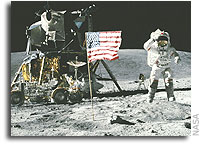NASA Space Pioneer John Young, Astronaut Without Equal, Retires

Space pioneer John W. Young, a man who flew twice to the
moon, walked on its surface and commanded the first Space
Shuttle mission, is retiring.
Young’s achievements during his 42-year career at NASA are
unmatched. He was the first human to fly in space six times
and launch seven times, six times from Earth and once from
the moon. He is the only astronaut to pilot four different
types of spacecraft, flying in the Gemini, Apollo and Space
Shuttle programs. Young is the longest serving astronaut in
history. His retirement from NASA is effective Dec. 31.
“John’s tenacity and dedication are matched only by his
humility,” said NASA Administrator Sean O’Keefe. “He’s never
sought fame and often goes out of his way to avoid the
limelight. However, when you need a job done and you want it
done right, John’s the person to go to. He’s a true American
treasure, and his exemplary legacy will inspire generations
of new explorers for years to come.”
Young, a native of Orlando, Fla., retired U.S. Navy Captain
and test pilot, joined NASA in 1962. His first mission was as
pilot of the maiden manned flight of the Gemini Program,
Gemini 3 in 1965. With Young and Commander Virgil Grissom on
board, Gemini 3 was the first American space flight with more
than one person.
He next flew in 1966, commanding Gemini 10. Along with Mike
Collins, he performed the first dual rendezvous maneuvers
during a single mission.
In 1969, two months before man’s first landing on the moon,
Young orbited Earth’s satellite.
Young orbited the moon in the Apollo Command Module, while
his fellow crewmembers, Thomas Stafford and Eugene Cernan,
descended to within 50,000 feet of its surface in the Lunar
Module. Apollo 10 was a full rehearsal for the first lunar
landing.
Young returned to the moon in 1972 as commander of Apollo 16.
He piloted the Lunar Module to a landing on the surface,
along with Charlie Duke. Young and Duke drove more than 16
miles across the lunar surface in the Lunar Rover Vehicle,
collecting more than 200 pounds of samples. It was the most
extensive lunar exploration mission to date.
“You run out of superlatives when you talk about Captain John
Young as a test pilot, astronaut and engineer,” said former
Space Shuttle astronaut and Associate Administrator for Space
Operations William Readdy. “John has an incredible
engineering mind, and he sets the gold standard when it comes
to asking the really tough questions. When he talks,
everybody listens. It’s impossible to overstate the positive
impact John has had on human space flight operations and
safety. Beyond that, he has set a standard for excellence for
all those who have served with him and those who will follow.
He’s truly an inspiration,” Readdy said.
Young was at the helm of Columbia for the first Space Shuttle
mission, STS-1 in 1981, with Robert Crippen as pilot. It was
the world’s first flight of a reusable, winged spacecraft;
the first landing of a spacecraft on a runway; and the
largest, heaviest craft to launch and land to date. It was
the first time a manned spacecraft was launched without
previous unmanned test flights. Young guided the 96-ton
Columbia to a perfect touchdown at Edwards Air Force Base,
Calif., after a two-day mission.
Young’s sixth and final space mission was again in command of
Columbia on the ninth Shuttle flight, STS-9 in 1983. It was
the first launch of the Spacelab laboratory in the Shuttle’s
cargo bay. It was the longest Shuttle flight to date, with
the first international crew working around the clock for 10
days to conduct more than 70 experiments.
When he was not in flight, Young’s extensive contributions
continued on the ground. He served as chief of NASA’s
Astronaut Office for 13 years. He also served eight years as
an assistant and associate director of NASA’s Johnson Space
Center, providing advice and counsel on technical,
operational and safety matters.
“John Young has no equal in his service to our country and to
humanity’s quest for space,” said the Director of NASA’s
Johnson Space Center, Jefferson D. Howell Jr. “He is the
astronaut’s astronaut, a hero among heroes who fly in space.
His achievements have taken space from an unknown environment
to the expanding frontier we explore today. His steady hand
and unflinching eyes have served our cause of space
exploration well, expanding our horizons with unshakable
dedication and calm courage. He will be missed,” Howell said.
For complete biographical and other information about John
Young, visit:









